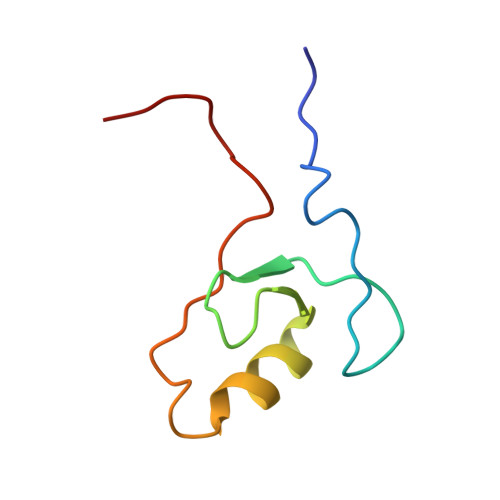The C-Terminal Region of Cytoplasmic Polyadenylation Element Binding Protein Is a ZZ Domain with Potential for Protein-Protein Interactions.
Merkel, D.J., Wells, S.B., Hilburn, B.C., Elazzouzi, F., Perez-Alvarado, G.C., Lee, B.M.(2013) J Mol Biol 425: 2015-2026
- PubMed: 23500490
- DOI: https://doi.org/10.1016/j.jmb.2013.03.009
- Primary Citation of Related Structures:
2M13 - PubMed Abstract:
Cytoplasmic polyadenylation element binding protein (CPEB) provides temporal and spatial control of protein synthesis required for early development and neuronal synaptic plasticity. CPEB regulates protein expression by inhibiting polyadenylation of selected mRNA transcripts, which prevents binding of the ribosome for protein synthesis. Two RNA recognition motif domains and a C-terminal binuclear zinc-binding domain are required for mRNA binding, but the zinc-binding domain is not required for sequence-specific recognition of the targeted mRNA transcript. The structure and function of the zinc-binding domain of CPEB are unknown. The C-terminal region of CPEB may participate in assembly of the ribonucleoprotein complex that includes the scaffold protein, Symplekin, and the cleavage and polyadenylation specificity factor. Sumoylation of Symplekin is required for polyadenylation, and both cleavage and polyadenylation specificity factor and poly(A) polymerase are sumoylated. The foreshortened poly(A) tail is maintained by poly(A) ribonuclease, which associates with CPEB. While zinc-binding domains are renowned for nucleic acid recognition, binuclear zinc-binding structural motifs, such as LIM (Lin-11, Isl-1, Mec-3), RING (really interesting new gene), PHD (plant homeodomain) and ZZ (ZZ-type zinc finger) domains, participate in protein-protein interactions. Here, we report the solution structure of the C-terminal zinc-binding domain of CPEB1 (CPEB1-ZZ), which has a cross-braced zinc binding topology. The structural similarity to other ZZ domains suggests that the CPEB1-ZZ domain recruits sumoylated proteins during assembly of the ribonucleoprotein complex prior to mRNA export from the nucleus.
Organizational Affiliation:
Department of Chemistry and Biochemistry, Southern Illinois University, 1245 Lincoln Drive MC 4409, Carbondale, IL 62901, USA.















